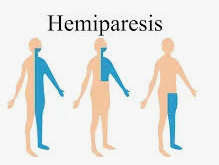Overview
Hemiparesis is the medical term for weakness on one side of the body. It is an early sign of stroke and transient ischemic attacks (TIAs). If you experience sudden hemiparesis in a limb or your face for an unknown reason, you should immediately go to the nearest emergency room (ER). Having this symptom unexpectedly can be an early sign of a stroke. You should also seek immediate medical help if you have any other signs of stroke, including balance issues, vision changes, face and arm drooping and speech difficulties. Hemiparesis is a common after-effect of stroke that causes weakness on one side of the body. This one-sided weakness can limit your movement and affect all basic activities, such as dressing, eating, and walking. People often confuse hemiparesis and hemiplegia. Both conditions occur as the result of a stroke.
Symptoms of hemiparesis
Common signs and symptoms of hemiparesis may include:
- difficulty walking and standing
- loss of balance and coordination
- numbness or tingling on one side of the body
- weakness in one arm or leg
- weakness in one side of the face that causes drooping of an eyelid or corner of the mouth
- numbness or weakness in the tongue that interferes with speech and swallowing
- asymmetry in one side of the body (e.g. lifting both arms and having one of them not come all the way up)
Diagnosis
Blood Tests
Complete blood count. This includes a check for your level of platelets, which are cells that help clot blood. A lab will also measure electrolyte levels in your blood to see how well your kidneys are working.
Clotting time. A pair of tests called PT (prothrombin time) and PTT (partial thromboplastin time) can check how quickly your blood clots. If it takes too long, it could be a sign of bleeding problems.
Imaging Tests
Computerized tomography (CT). Your doctor takes several X-rays from different angles and puts them together to show if there’s any bleeding in your brain or damage to brain cells. They may put dye in your vein first to look for an aneurysm, a thin or weak spot on an artery.
Magnetic resonance imaging (MRI). This uses powerful magnets and radio waves to make a detailed picture of your brain. It’s sharper than a CT scan and can show injuries earlier than a traditional CT.
Carotid ultrasound. This uses sound waves to find fatty deposits that may have narrowed or blocked the arteries that carry blood to your brain.
Echocardiogram. Sometimes a clot forms in another part of the body (often the heart) and travels to the brain. This imaging test of the heart can look for clots in the heart or enlarged parts of the heart.
Angiograms of your head and neck. Your doctor will put dye in your blood so they can see your blood vessels with X-rays. This can help find a blockage or aneurysm.
Treatment for Hemiparesis?
Hemiparesis treatment may include medical and nonmedical techniques:
- Electrical stimulation. As part of this method, small electrical pads are placed on the weak muscles of the side that has hemiparesis. An electrical charge is sent to the body that helps the muscles contract. Some of these machines can be used at home once you learn how to use them.
- Cortical stimulation. This is a bit similar to electrical stimulation, except that the electric current is sent to the tough membrane covering the brain (called the dura). While your brain is subjected to this current, you have to do rehabilitation exercises.
- mCIT. Modified, constraint-induced therapy is a treatment method that forces you into using the weak side of the body. With regular practice, nerve function may improve in the region. mCIT works well when used with other therapies.
Treating Right Sided hemiparesis
A physical therapist can recommend the appropriate device. Braces, canes, walkers and wheelchairs can increase strength and movement. An ankle-foot orthosis brace can help control your ankle and foot. Repeated practice and regular activity will help increase control and flexibility and re-establish nerve circuitry.
Possible complications or risks of not treating hemiparesis
The risks of not treating it can be high. In the worst cases, it can result in permanent brain damage, paralysis, loss of abilities or even death.
Conclusion/Takeover
A stroke happens when the flow of blood to part of your brain gets cut off. This means your brain can’t get oxygen, and without that, brain cells can be damaged in minutes. That’s why it’s important to get to the emergency room right away if you think you’re having a stroke. You might need a clot-busting drug within the first 3 hours.
The F-A-S-T test is an easy way to remember them:
- Face: Smile. Does one side of your face sag?
- Arms: Raise both and see if one droops.
- Speech: Say a common phrase: Does it sound strange or slurred?
- Time: Call Ambulance service right away if you notice any of these symptoms. Note what time they started.
For any medical assistance or free opinion from our top doctors feel free to email us your query at query@gtsmeditour.com or whats app us on +91 9880149003
Happy to help..!
Thank you..!


Post a comment